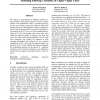Free Online Productivity Tools
i2Speak
i2Symbol
i2OCR
iTex2Img
iWeb2Print
iWeb2Shot
i2Type
iPdf2Split
iPdf2Merge
i2Bopomofo
i2Arabic
i2Style
i2Image
i2PDF
iLatex2Rtf
Sci2ools
ISIPTA
1999
IEEE
1999
IEEE
Modeling Ellsberg's Paradox in Vague-Vague Cases
We explore a generalization of Ellsberg's paradox (2color scenario) to the Vague-Vague (V-V) case, in which neither of the probabilities (urns) is specified precisely, but one urn is always more precise than the other. One hundred and seven undergraduate students compared 63 pairs of urns involving positive outcomes. The paradox is as prevalent in the V-V case, as in the standard PreciseVague (P-V) case. The paradox occurs more often when differences between ranges of vagueness are large and occurs less often with extreme midpoints. The urn with more vagueness was avoided for moderate to high expected probabilities and preferred for low expected probabilities in P-V cases, and the opposite pattern was found for the V-V cases. Models that capture adequately the relationships between the prevalence of vagueness avoidance and the lotteries' parameters (e.g. differences between the two ranges) were fitted for the P-V and V-V cases. Keywords. Vagueness, ambiguity, imprecise proba...
| Added | 04 Aug 2010 |
| Updated | 04 Aug 2010 |
| Type | Conference |
| Year | 1999 |
| Where | ISIPTA |
| Authors | Karen M. Kramer, David V. Budescu |
Comments (0)

